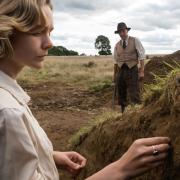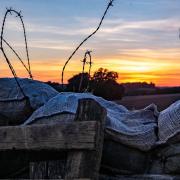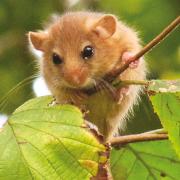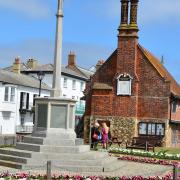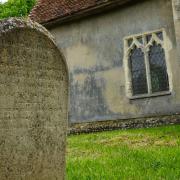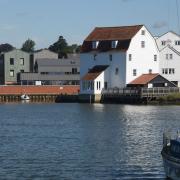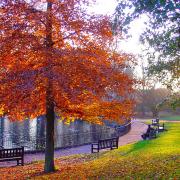It’s 70 years since the RSPB took over the conservation and management of Suffolk’s only island, rare and fragile wildlife habitat under constant threat from the forces of the sea | Words & Photos: Mike Trippitt

October Storm, an RSPB workboat, eases away from Orford quay in blazing sunshine and a gentle breeze. Purposefully, she pushes into the tide for the 20-minute hop across the River Alde to Havergate Island.
At the helm, warden Lyndsey Record, who has worked on the RSPB island reserve since 2014, is confident and relaxed. “I’ve always had an interest in islands,” she says. “I had in my mind that I wanted to work on an island, so when this job came up I obviously applied for it. I love being away from everyone. I like having to get a boat out here. It’s challenging. When we’re building a hide, we have to bring all the tools and wood out by boat. It makes it more interesting.”

The RSPB took over Suffolk’s only island 70 years ago in 1948, following neglect during the second world war, and ownership passed to the society the following year. “The RSPB’s interest in the island began when avocets started breeding here” says Lyndsey.
“They hadn’t bred in Britain for a long time.” The avocet’s return to the UK in 1947, after an absence of 100 years, led the RSPB to adopt the bird as its emblem. It also led to acquisition of the Minsmere and Havergate reserves and to a programme of sustained conservation in the heart of Suffolk.

Havergate’s six saline lagoons lie one mile south of Orford. The two-miles long island began life 500 years ago, as a shingle bank at the confluence of the Butley river and River Alde. Later, marshkeepers built seawalls to prevent the tide swamping the marsh and pastureland.
The island has been farmed and grazed, and for a short time from 1923, there was even a quarry there. Human occupation ended in the 1920s, and the few brick foundations, two iron wheels, a decaying jetty and three partially buried bogey carts are all that is left of its agricultural and industrial past.

Yet the island is unique. Its grasses, saltmarsh, vegetated shingle and gorse provide a rich and diverse habitat for hundreds of species of invertebrates, mammals, fauna and birds. Havergate is open to the public except in May, June and July, when its large gull population nests and chicks are in abundance. Lyndsey says the best time for people to visit to see birds is in the winter.
“Although it is cold out here, they will see wildfowl and ducks. In the summer and autumn we get spoonbills. In the spring and autumn we get the waders passing through – lapwing, avocets, redshanks, curlews, whimbrels, dunlin, turnstones. In the early spring the gulls come in. We have 3,000 big gulls here – lesser black-backed gulls and herring gulls, mainly.”

Although Havergate is an RSPB reserve and popular with birders, Lyndsey says other groups come to the island to enjoy its special qualities. She takes photographers and artists, as well as those interested in nature generally. She is even developing a tour focusing on the history of the island.
She secures October Storm to the RSPB buoy and rows the tender ashore to be met by residential volunteer Mike Matthewson. Although RSPB no longer recruits residential volunteers to work on Havergate, Mike has been staying on the island for up to three weeks at a time since 2006.
He is one of a handful of residential volunteers that Lyndsey relies on to assist with maintenance, building, wildlife monitoring, and water level and salinity management.

“I love the place,” says Mike, a retired zoologist and parasitologist. “It is just marvellous. You get a taste for islands because of the isolation. It is not being anti-social, it’s just wonderful being on your own. You have to be more self-sufficient and plan better. You have to be self-motivated to get up and get on with jobs, because you could just sit here and not do anything.”
The work that Mike does on the island, as well as that done by day volunteers on the weekly work parties, is never-ending. Maintenance of the reserve is a perennial battle against the elements and tides. Since 2002, two tidal surges have caused significant damage. According to Mike, the first forced a boardwalk up in the air like the front of an aircraft carrier.
“In 2013 the place was completely swamped. I wasn’t here at the time, but was here before it and after it. Boardwalks were lifted out of the grounds. Bridges were damaged. Signage and benches were moved metres from where they should have been. Not devastation, but really bad damage, mud and mess.”

Hides were also damaged and displaced. Yet Mike says it is surprising how quickly the island’s wildlife gets back to normal. “There are some positive things about [a tidal surge], because it will bring enriched material into the island. It makes vegetation grow better in the lagoons, provides more invertebrates, and flushes things out.”
Ten years ago, the RSPB predicted that Havergate had a remaining lifespan of between 30 and 50 years, and would ultimately succumb to erosion. That assessment hasn’t changed but Lyndsey says it is very difficult to tell.
“We don’t know how long, but there are signs, especially more recently, of erosion. In 2013 the tidal surge breached a couple of the walls around the lagoons. As the water came in, it scoured the edges of the lagoons around the inside making the walls quite weak. We had to build them up, but it’s possible they’re never going to be as strong as they were.” The solution was to lower a 150-metre section of wall and made the banks less steep.

“Since we lowered the wall it’s been fantastic, because when the water flows in, we open the sluices and it flows out. It doesn’t cause any damage. In the autumn we’re lowering 700 metres of seawall. We’ll make the banks less steep, put rock-fall netting over it and grass seed it.
“This is to protect the lagoons and seawalls, so that in the event of surges, the water just flows in without damaging the walls.” But Lyndsey accepts that water cannot be kept out of the low-lying island and one day it will disappear. Meanwhile RSPB will manage the changes and continue to provide a home for nature.
It’s time to leave Havergate and, as she returns to October Storm, Lyndsey hands Mike a tiny butterfly that has settled on her bag. “Can you put it back on the island?” she says. “I don’t want to take him with me.” Mike waves her off and looks forward to another night alone.
“To sit here in the evenings, on your own, and watch a Thames barge go past, especially in the long hours in the summer, is just amazing. It’s a real privilege.”
Acting locally
Every August, Woodbridge RSPB local group organises the Havergate Adventure, a guided walk on the island to look at birds. Since it started in 1987 it has raised over £60,000 for the society.
Group leader Paul Hetherington says it’s mainly about people having an experience which brings them closer nature: “Birds are part of an environment, everything is connected. If you don’t have voles, you don’t have owls. If you don’t have mice, you don’t have buzzards. If you don’t have insects, you don’t have swifts, swallows and martins.”
In this way, the RSPB is not just about birds but protecting the wider environment, and the local groups provide opportunities for people who are not just interested in birds, but in nature generally to meet up and share experiences. Meetings and trips are open to everyone, RSPB members and non-members alike. To find a local group visit rspb.org.uk
__________________




